Mail art by Ruud Janssen (Breda, Netherlands)
Part II
March 27, 2015 - I am thrilled to present a new installment of a three-part blog series featuring new work released in early 2015 by artist, mail art scholar/historian and IUOMA founder Ruud Janssen. The envelopes for these mailings have been especially powerful (and Ruud Janssen is already renowned in the Eternal Network for his envelope art). Others in this series and related items can be found documented online elsewhere too.
The envelope (above) announces a consistent theme that runs through these recent mailings: technology, humanity, and the future. The related topic of digital vs. hard copy communication and the future has a very specific relevance to mail artists and is likely to generate heated discussions among the artists whenever the subject is raised.
Note that Ruud Janssen’s envelope also includes an IUOMA-5089 stamp, marking participation in Moan Lisa’s (Iowa, USA) Post Mail Art Movement:
Moan Lisa is incredibly prolific, circulating large amounts of work through the postal system and via the digital realm. While not clearly defined to my knowledge, the Post Mail Art Movement seems to suggest a new order for correspondence art and the network integrating snail mail and the digital realm. Perhaps it is an extension of Dick Higgins’ Intermedia concept.
The contents of the envelope continue and extend the technology, humanity and the future theme with another poster-size print of Ruud Janssen’s recent work using computer technology motifs. This one is entitled “diode dance.” Text is freely integrated with the visual arts elements reminiscent of Ben Vautier’s celebrated communications. As in Part I, the scale of the print could not be captured by my printer, so I had to copy it in two pieces, which does not do much for continuity:
In response to Ruud Janssen’s question: Blogging and maintaining an online presence (aka screwing around with friends on the internet) does indeed consume much of the limited time I can commit to mail art. I have made my view on the digital vs. snail mail dichotomy clear in a number of venues, a subject that can send some individuals into convulsions.
First, I refer to a statement Ray Johnson made in an interview with John Held Jr. in the 1970s. Ray Johnson said: “Mail-art is not about the postal system.” I take this to mean mail-art is about a network of like-minded people exchanging ideas and art not about preserving and worshipping any particular conduit of communication, such as the postal system. I believe mail art today is a hybrid activity involving both online activity and use of the postal system. (Other networking activities might include phone calls and meet-ups.) I encourage this hybrid strategy.
But I do not advocate abandoning the postal system altogether or discontinuing hard copy archives. For me, mail art does not simply become email art. I have had interesting, back channel discussions with a number of veteran mail artists who are very concerned that the potential for artistic freedom that the internet once promised is fading and could well disappear as we now know it. The more paranoid recommend keeping hard copies of everything as those who rely on data storage solely could awaken one day to find all their holdings have simply vanished. Thus, contemporary mail art involves participation in several different paths of communication and storage simultaneously. Adaptability and flexibility are essential.
I admire the romantic notion of mail artists who have gone “off the grid” and only communicate with a closed network “on the ground.” This has the underground feel of the old network, the outlaw appeal. In reality, and I can think of a few artists I admire who have unplugged, this approach is limiting and excludes the artist from many opportunities for innovation.
What I fear most is a notion of mail art that makes a fetish of the mailbox, worship of an obsolete or dying technology and disdain and rejection of the new. Luddite is the worst possible expression to describe this tendency. This viewpoint could make mail art the kind of activity that involves dressing up in costumes and pretending to live in the past (usually a past that never really existed). This is akin to people who travel on weekends to parks where there are log huts and – in costume – they demonstrate things like how to make candles or clip goats, whatever. Something like that is cool and maybe even useful, but it doesn’t capture the spirit of mail art and shouldn't be a model for what mail art is to become. Mail art should not be about recreating an activity that most people do not do any more because there is a better way to do it. Mail art has always been about blazing new trails and doing thing differently.
I am not concerned about mail art changing, and it is. I would be more concerned if it were not changing or, in a sense, moving backward, drawing within itself, becoming self absorbed. Any vital and dynamic cultural practice evolves, experience disruptions and displays continuities. Mail art appears healthy precisely because it is changing and, I believe, adapting.
So that is my response to Ruud Janssen’s interesting question. Here is another view of “diode dance”:
“diode dance” – image courtesy of Ruud Janssen
Many thanks to Ruud Janssen for this wonderful work, and stay tuned for Part III. To see Part I of the series, click
http://iuoma-network.ning.com/profiles/blogs/unfinished-writing-by-...
Comment
-
Comment by Carmela Rizzuto on May 17, 2015 at 5:17pm
-
Very insightful thoughts on the evolution of mail art and its processes. Thanks de Villo (and Rudd)!
-
Comment by Ruud Janssen on March 31, 2015 at 6:56am
-
thanks for the answers to the questions and the interesting blog and the many reactions already....!
-
Comment by Ruud Janssen on March 31, 2015 at 6:55am
-
you can't digitize emotions because they are analog and have a different scale for everybody. I focus on what people believe is possible in the digital world, because we want to make such a digital impact in the future.....
-
Comment by borderlinegrafix on March 29, 2015 at 1:26am
-
I'd like to ramble on about the technological revolution and the digital age. As one of my close friends observed recently, "It used to be cool to know things". In other words, if 2 out of 3 people have a smart phone, knowledge [or supposed knowledge] is at your fingertips. So much for games like Trivial Pursuit. This means, I think, that our brains will slowly change over time because of the smartphone phenomenon. But more quicker to change is the social norms that we all abide by. Two people sitting at at table for dinner in public should not be staring at their phones, they should be interacting on a personal, human level. Digital platforms such as IUOMA enhance the worldwide yearn for connectivity - I feel the personal touch through digital when R. Canard sends me a missive about Communism and its historical effects on this website. I get teared up when I learn of someone's personal loss - even my loss of a dear mail art friend communicated through IUOMA. So the dance is available to everyone.
Is the digital conceptual or concrete? Is it both? Is mail art conceptual or concrete? Is it both?
I would like to think you can have your cake and eat it too, and as Mike Dyar would exclaim, "EAT ART".
I have a dumb flip phone but I like to get online and check it out. I pay for the middling internet speed but want everything now, just like Google Fiber provides. I enjoy communication. I reject isolation. Will we still look at clouds and wonder about the natural world? Will we act upon our desire for the natural world? Stamps, envelopes, writing, watercolors, ink, inkjet, my postal carrier, tearing collage bits, scanning, digital jpegs, paper, --it all blends, the digital and concrete.
We have to say that this is a new thing.
As we had Arts and Crafts and Pre-Raphaelites in the age of the Industrial Revolution, we will have other movements in the Information Age. Just ask tENT or Moan.
-
Comment by De Villo Sloan on March 28, 2015 at 4:05pm
-
Richard, this one is very serious. No humorous Fluxus performances going on in this thread.
You might have noticed that ponderous IUOMA discussions have been devoted to the future of mail art and the use of technology vs. snail mail. Ruud Janssen's recent technology-rooted pieces address larger issues of humanity/technology, I think. Yet thoughts circle inherently back to mail art and it's relationship to the digital. His question to me seems to address mail art specifically and my own online presence and the survival of all these "texts" in the future.
Digging back into the 90s (when I was mostly absent) I find (w/research) people were grimly pronouncing the death of mail art. Maybe Ray Johnson's death represented that symbolically. Thing is, those people were wrong. Mail art appears to be thriving. The digital realm has turned out to be a friend.
We have extremely diverse positions here and now ranging from a Luddite stance to people who suggest abandoning snail mail altogether but still consider themselves mail artists. So I re-stated my own position, which is well known to friends any way. People can get very passionate about this, no question.
Actually, Richard, you are an interesting example of an "evolutionary surfer," as Timothy Leary used to call such individuals. Your identity, reputation and practices were formed in a time when the internet was still science fiction. (I don't mean you're old; it happened very fast.) Yet here you are embracing the strategies of the newer generations (so am I). Moan Lisa is a great example of the contemporary mail artist - a digital construct, yet s/he is a voluminous mailer.
Personally, I go with a point raised by BG, I think. It's hard to be an online presence and churn out massive amounts of mail. I tend to do more online, but I do regular mailings, just small and selective. My defense is I "paid my dues" in the 80s and into the 90s sending out hundreds of items a month over a period of many years - consistently.
Richard, your adaptability and my arrested development are exceptions to the rule. Sadly, I see many seasoned people on FB (people I admire deeply) who don't send anything out anymore. They continually claim everything was better and perfect "back in the day" and everyone and everything connected to the current scene, excuse me, sucks. That's really sad.
Shouldn't we be supporting and encouraging the new groups and generations (because it's not so much age as the state of the network when you're active that defines a generation)? Shouldn't we recognize that things change and because things aren't the way they were in 1989 or 1979 or 1969, that doesn't mean they are wrong?
So this was a place to re-state my position, although it sort of bores me in the same way this endless haggling about Fluxus and Post-Fluxus bores me.
I do appreciate you as a fellow traveler, Richard. It's a thrill. BG too, although I know him less, but he knows about the history of this and what it was like to live it.
So thanks again.
-
Comment by Richard Canard on March 28, 2015 at 3:31pm
-
28.03.15 Dare De Villo S., ...as Ruud J. states: "Good to see you are still so active on line." ... I find that reading your commentary is usually helpful in me getting some idea of what is really going on here (i.e. the individual IUOMA mailings & the state of Mail Art in general.)...Thanks for all that you do as I know you are also most capable at the act of play. Best to you. Richard Canard
-
Comment by borderlinegrafix on March 28, 2015 at 12:00pm
-
The blog is great, it focuses on the points of difference and similarities between the information revolution and human evolution. I guess we don't live in a vacuum, and that is what Ruud is interested in, I think (humbly).
Where would we be without theoretical propositions, utopian yearnings, etc. Thanks for the words, DVS.
-
Comment by De Villo Sloan on March 28, 2015 at 10:58am
-
Thanks, BG. Some of us do tend to speculate and theorize.
Grigori Antonin, for one, didn't feel it was productive and used to say something like: "Make art. Mail [verb] art. Receive art." That's all you need to know and do.
-
Comment by borderlinegrafix on March 28, 2015 at 3:16am
-
There is a very base common thread between digital and 'boots on the ground' mail art:
With digital, it is either a zero or a 1.
With postal, it is either you put it in the mailbox, or you don't.
© 2025 Created by Ruud Janssen.
Powered by
![]()
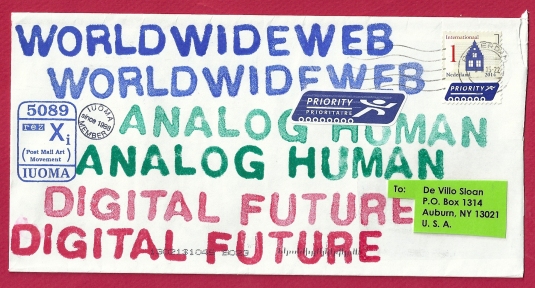
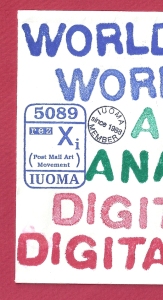
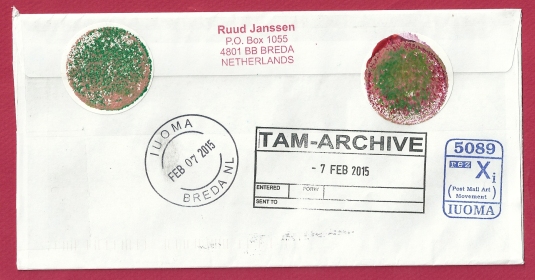
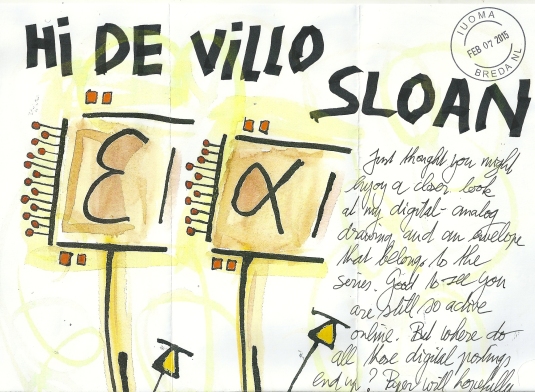
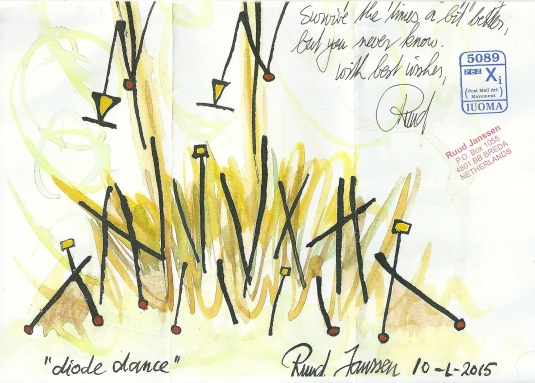
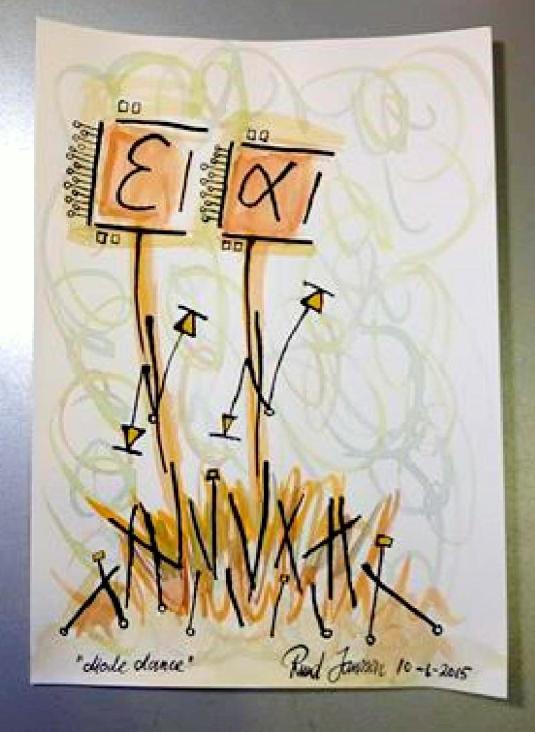
You need to be a member of International Union of Mail-Artists to add comments!
Join International Union of Mail-Artists